Preface
The Shader section actually has quite a bit of existing work, such as the
As for why you would rebuild your own wheels… There’s time. What other reason is there? Besides (knock on wood) the final realization is going to be in Blender…
PV: Love, love, love

Debugging Metal in Xcode even has resource dependencies rendered the Render Graph way… Cook thank you so much 🥲

The previous post didn’t look toward the work before SRP post-processing; here’s a straight shot at SRPBatcher Pass
Coincidentally, this Pass processing contains the character part, which is analyzed step by step below.
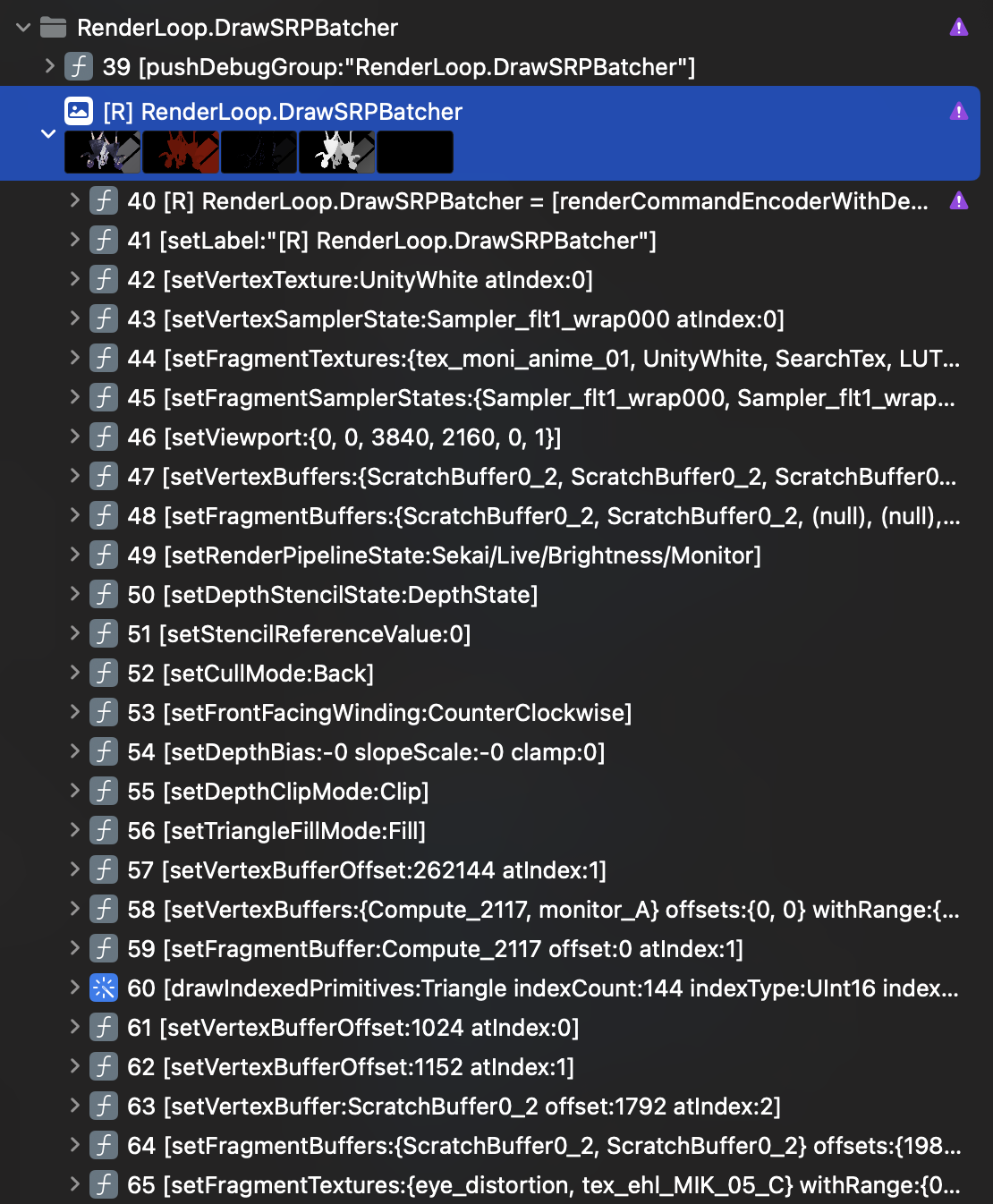
Note: Vectors will be shown in the direction of the diagrams.

1. Eye-Highlight
A brief summary of the effect - i.e. adding cartoon-style highlights to the character’s eye expression.
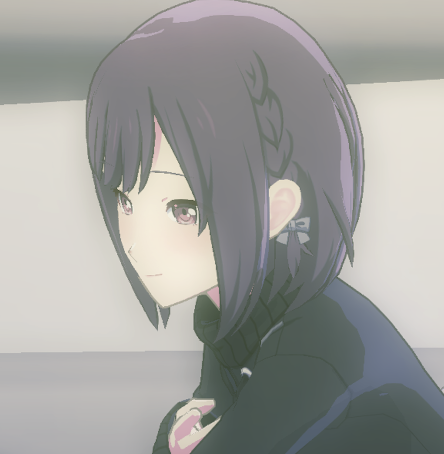
This part is expressed by the extra mesh (note the abbreviation ehl), which appears as the first mesh in Pass
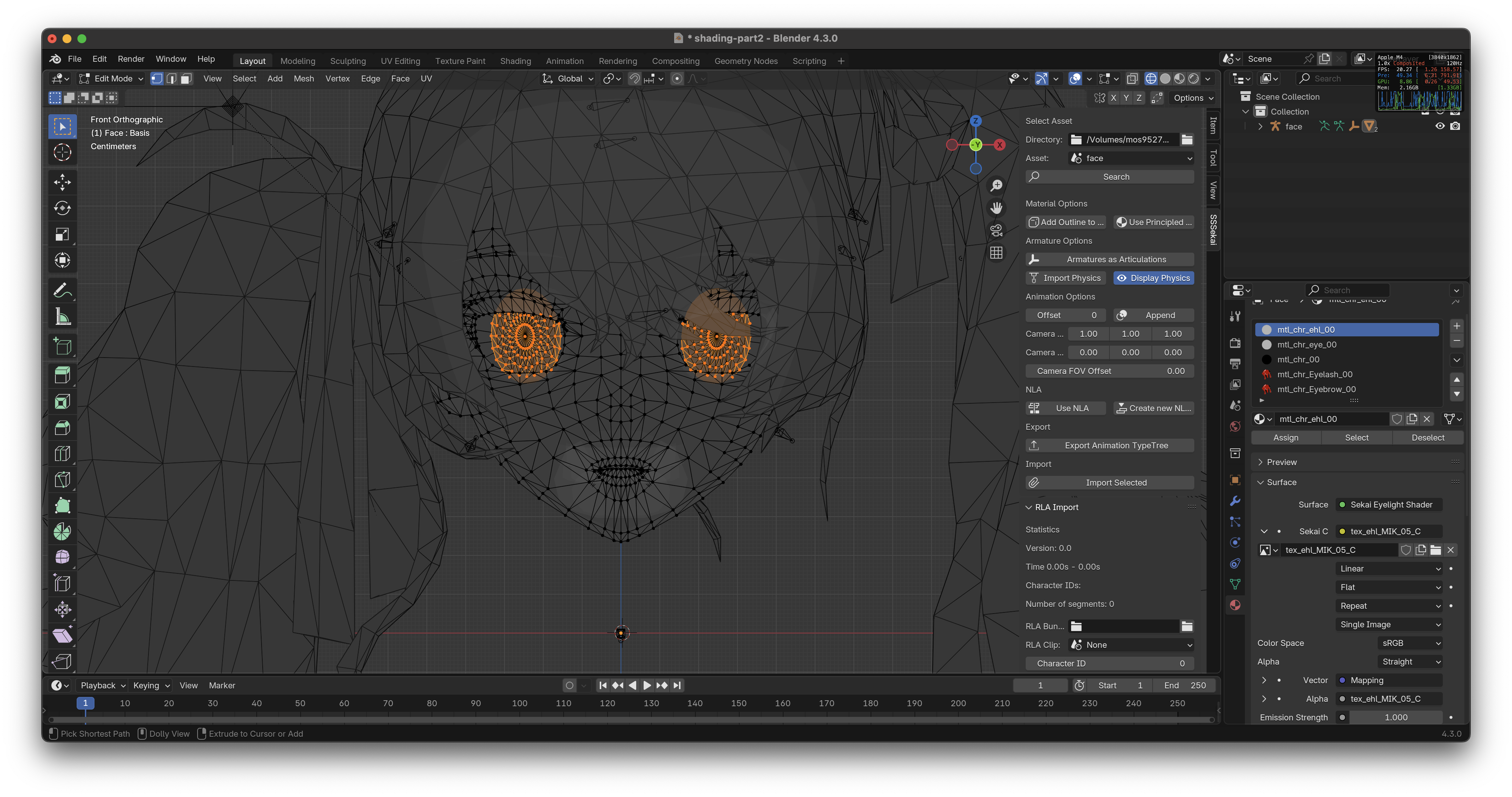
Going back to Metal debugging and observing the decompilation reveals a few details about the effect
Highlight ‘shimmer’ effect
u_xlat0.x = FGlobals._SekaiGlobalEyeTime * UnityPerMaterial._DistortionFPS; u_xlat0.x = floor(u_xlat0.x); u_xlat0.x = u_xlat0.x / UnityPerMaterial._DistortionFPS; u_xlat1.x = u_xlat0.x * UnityPerMaterial._DistortionScrollX; u_xlat1.y = u_xlat0.x * UnityPerMaterial._DistortionScrollY; u_xlat0.xy = fma((-u_xlat1.xy), float2(UnityPerMaterial._DistortionScrollSpeed), input.TEXCOORD5.xy); u_xlat16_0.xy = _DistortionTex.sample(sampler_DistortionTex, u_xlat0.xy).xy; u_xlat16_2.xy = fma(u_xlat16_0.xy, half2(2.0, 2.0), half2(-1.0, -1.0)); u_xlat0.xy = float2(u_xlat16_2.xy) + float2(UnityPerMaterial._DistortionOffsetX, UnityPerMaterial._DistortionOffsetY); u_xlat1.x = UnityPerMaterial._DistortionIntensity * UnityPerMaterial._DistortionIntensityX; u_xlat1.y = UnityPerMaterial._DistortionIntensity * UnityPerMaterial._DistortionIntensityY; u_xlat0.xy = fma(u_xlat0.xy, u_xlat1.xy, input.TEXCOORD0.xy); u_xlat0.xyz = float3(_MainTex.sample(sampler_MainTex, u_xlat0.xy, bias(FGlobals._GlobalMipBias.xyxx.x)).xyz); ... u_xlati18 = UnityPerMaterial._CharacterId; u_xlat1.xyz = float3(u_xlat16_3.xyz) * FGlobals._SekaiCharacterAmbientLightColorArray[u_xlati18].xyz; u_xlat16_4.xyz = half3((-u_xlat0.xyz) + float3(1.0, 1.0, 1.0)); u_xlat16_4.xyz = u_xlat16_4.xyz + u_xlat16_4.xyz; u_xlat5.xyz = float3(1.0, 1.0, 1.0) + (-FGlobals._SekaiCharacterAmbientLightColorArray[u_xlati18].xyz); u_xlat5.xyz = fma((-float3(u_xlat16_4.xyz)), u_xlat5.xyz, float3(1.0, 1.0, 1.0)); u_xlat16_3.xyz = half3(fma((-float3(u_xlat16_3.xyz)), FGlobals._SekaiCharacterAmbientLightColorArray[u_xlati18].xyz, u_xlat5.xyz)); u_xlat16_2.xyz = half3(fma(float3(u_xlat16_2.xyz), float3(u_xlat16_3.xyz), u_xlat1.xyz)); u_xlat1.xyz = float3(u_xlat16_2.xyz) * float3(FGlobals._SekaiCharacterAmbientLightIntensityArray[u_xlati18]);Highlight mapping over time **UV on offset **post-sampling after the decision to brighten **based on the **ambient light intensity, while generating dynamic effects
Blender implementation
Effects that change over time mean that the current frame of the animation needs to be accessed in some way; right-click on
Timeline > Current Frameto copy the driver and put it in the shader.
To simplify the process, consider deciding the UV offset direction directly by taking the mold, so that only the $U,V$ direction size can be specified to produce the effect.
The Shader is implemented as follows

The effect is as follows
Ambient light impact is not considered for the time being and will be supported later.
2. Toon-V3
It can be observed that all other meshes go through this Pipeline; let’s start with the rendering of the non-Face part first
The tex used has not changed much.
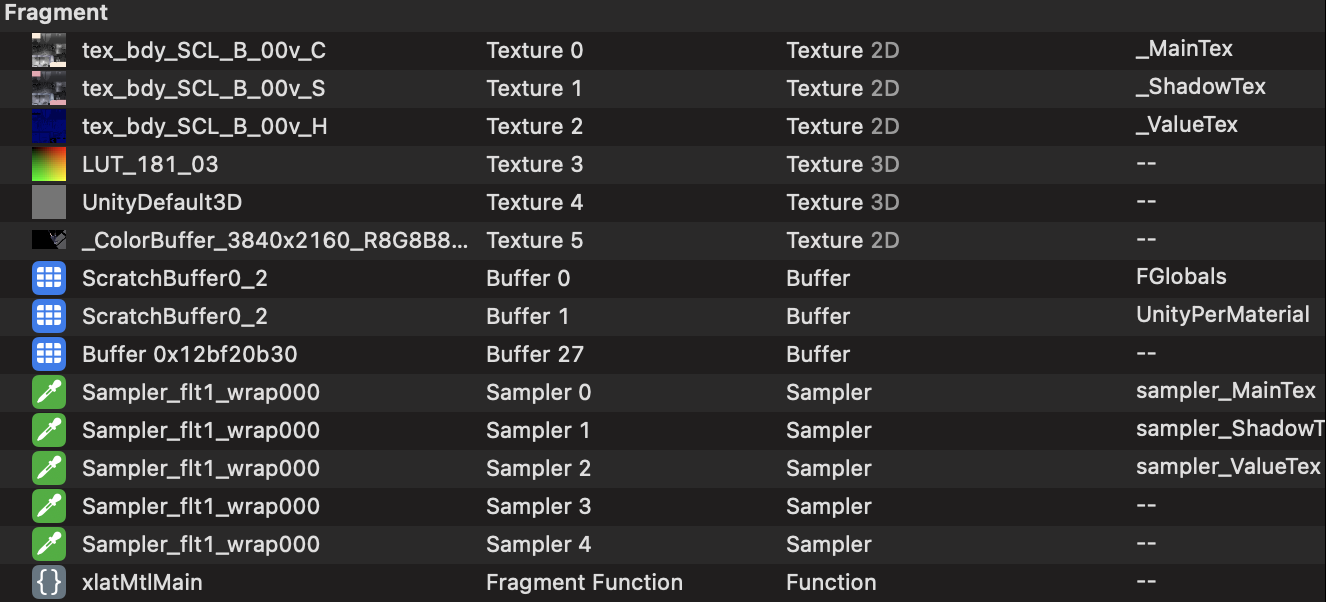
After some markup you can start the implementation, looking directly at the Shader decompiled code
Given that registers are multiplexed, as are variable names, I apologize for any reading inconvenience!
constructor
#include <metal_stdlib>
#include <metal_texture>
using namespace metal;
constant uint32_t rp_output_remap_mask [[ function_constant(1) ]];
constant const uint rp_output_remap_0 = (rp_output_remap_mask >> 0) & 0xF;
constant const uint rp_output_remap_1 = (rp_output_remap_mask >> 4) & 0xF;
constant const uint rp_output_remap_2 = (rp_output_remap_mask >> 8) & 0xF;
#define EXIT(X) output.SV_Target0 = half4(half3(X),1.0); return output;
struct FGlobals_Type
{
float2 _GlobalMipBias;
float4 _ZBufferParams;
float4 _SekaiDirectionalLight;
half4 _SekaiShadowColor;
half _SekaiShadowThreshold;
half4 _SekaiCharacterSpecularColorArray[10];
float4 _CoCParams;
float _SekaiAllLightIntensity;
float _SekaiCharacterAmbientLightIntensityArray[10];
float4 _SekaiCharacterAmbientLightColorArray[10];
float4 _SekaiRimLightArray[10];
float4 _SekaiRimLightColorArray[10];
float4 _SekaiShadowRimLightColorArray[10];
half4 _SekaiRimLightFactor[10];
half _SekaiRimLightShadowSharpnessArray[10];
float3 _SekaiGlobalSpotLightPos;
float4 _SekaiGlobalSpotLightColor;
float _SekaiGlobalSpotLightRadiusNear;
float _SekaiGlobalSpotLightRadiusFar;
int _SekaiGlobalSpotLightEnabled;
float4 _SekaiFogColor;
};
struct UnityPerMaterial_Type
{
float4 _MainTex_ST;
float4 _ShadowTex_ST;
float4 _ValueTex_ST;
float4 _FaceShadowTex_ST;
float4 _LightMapTex_ST;
float _BumpScale;
float _RimThreshold;
float _OutlineWidth;
float _OutlineL;
float _OutlineOffset;
float _SpecularPower;
float4 _DefaultSkinColor;
float4 _Shadow1SkinColor;
float4 _Shadow2SkinColor;
half _HeadNormalBlend;
half _EyelashTransparent;
half _EyelashFaceCameraEdge1;
half _EyelashFaceCameraEdge2;
half _IsLeftEyeClose;
half _IsRightEyeClose;
int _CharacterReflectionOff;
float3 _FaceFront;
int _CharacterId;
float3 _HeadPosition;
float _RangeLimit;
half4 _PartsAmbientColor;
float4 _HeadDotDirectionalLightValues;
float _ShadowTexWeight;
};
Pipeline Output
struct Mtl_FragmentIn
{
float3 NORMAL0 [[ user(NORMAL0) ]] ;
float4 COLOR0 [[ user(COLOR0) ]] ;
float4 TEXCOORD0 [[ user(TEXCOORD0) ]] ;
float4 TEXCOORD1 [[ user(TEXCOORD1) ]] ;
float3 TEXCOORD3 [[ user(TEXCOORD3) ]] ;
half TEXCOORD6 [[ user(TEXCOORD6) ]] ;
float3 TEXCOORD4 [[ user(TEXCOORD4) ]] ;
float TEXCOORD7 [[ user(TEXCOORD7) ]] ;
float3 TEXCOORD5 [[ user(TEXCOORD5) ]] ;
};
struct Mtl_FragmentOut
{
half4 SV_Target0 [[ color(rp_output_remap_0) ]];
half4 SV_Target1 [[ color(rp_output_remap_1) ]];
half4 SV_Target2 [[ color(rp_output_remap_2) ]];
};
You can see the use of the 3 MRTs; combined with the above it is easy to see that
SV_Target0as the main imageSV_Target1is the blurring circle depth for depth of fieldSV_Target2for Bloom with highlights
Obviously, the latter two only come in handy for post-processing - these are also outlined above.
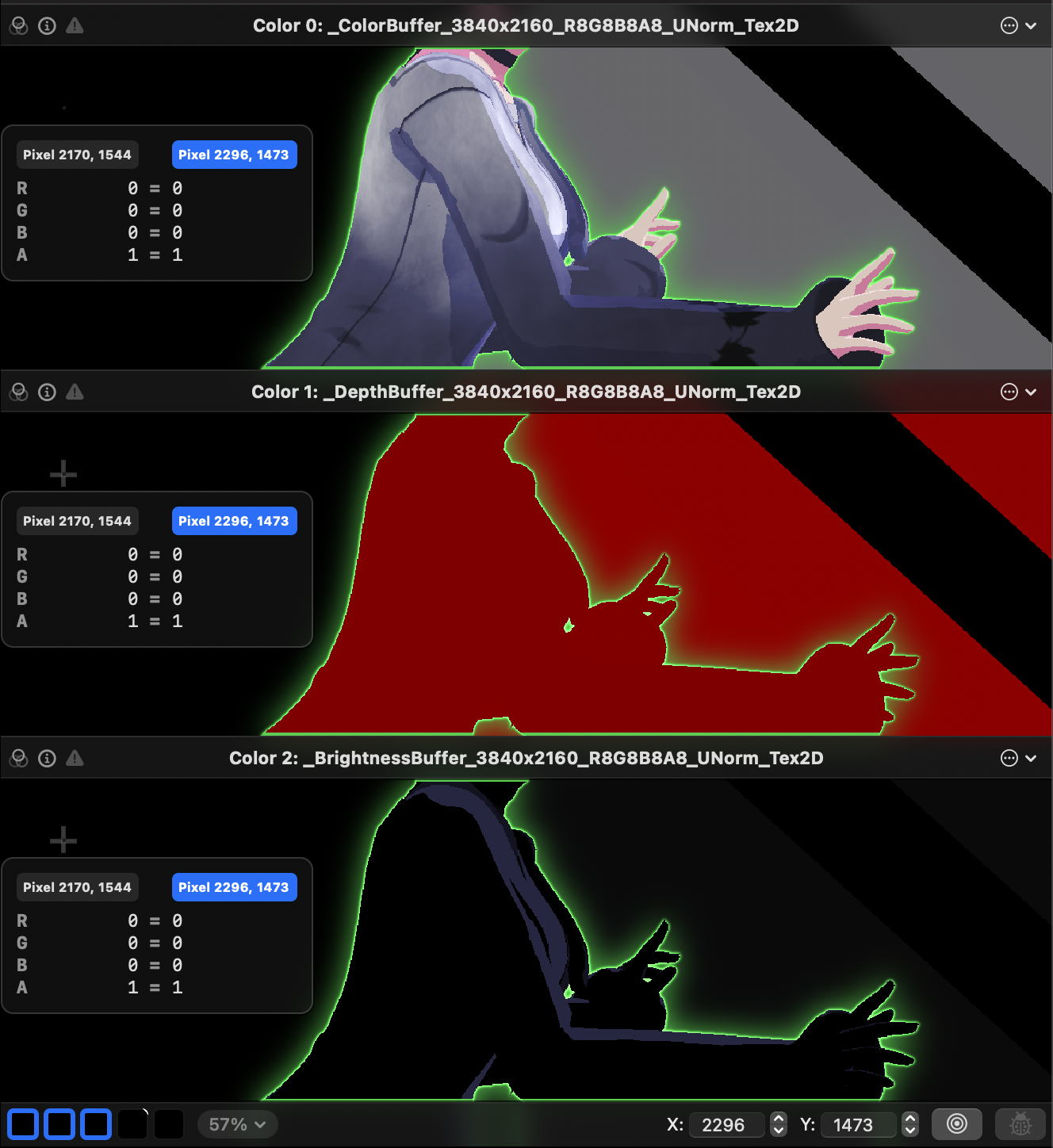
The next observations are about to be centered around the first RenderTarget
Pipeline Material
fragment Mtl_FragmentOut xlatMtlMain(
constant FGlobals_Type& FGlobals [[ buffer(0) ]],
constant UnityPerMaterial_Type& UnityPerMaterial [[ buffer(1) ]],
sampler sampler_MainTex [[ sampler (0) ]],
sampler sampler_ShadowTex [[ sampler (1) ]],
sampler sampler_ValueTex [[ sampler (2) ]],
texture2d<half, access::sample > _MainTex [[ texture(0) ]] ,
texture2d<half, access::sample > _ShadowTex [[ texture(1) ]] ,
texture2d<half, access::sample > _ValueTex [[ texture(2) ]] ,
Mtl_FragmentIn input [[ stage_in ]])
{
Mtl_FragmentOut output;
half4 mainTexSmp;
float3 shadowValue;
half3 shadowTexSmp;
bool u_xlatb1;
float3 u_xlat2;
int charaId;
half3 charaSpecular;
float4 u_xlat4;
half4 valueTexSmp;
bool4 u_xlatb4;
float3 u_xlat5;
half3 skinValue;
float3 u_xlat7;
half3 shadowValue6_8;
float3 shadowValue0;
float3 lumaValue;
int u_xlati11;
bool u_xlatb11;
half3 skinValue2;
float shadowValue9;
float u_xlat20;
int charaId0;
float u_xlat28;
bool u_xlatb28;
float rimIntensity;
half lumaOffset;
half charaSpecular3;
Except for the 3 materials, there is also a layer of Color information in the Mesh; their uses are described below.
For the sake of convenience, the following abbreviations are used here
MainTex: “C Tex”,$T_c$ShadowTex: “S Tex”,$T_s$Value Tex: “H Tex”,$T_h$
The prefix corresponds to the material name suffix _C,_S,_H.
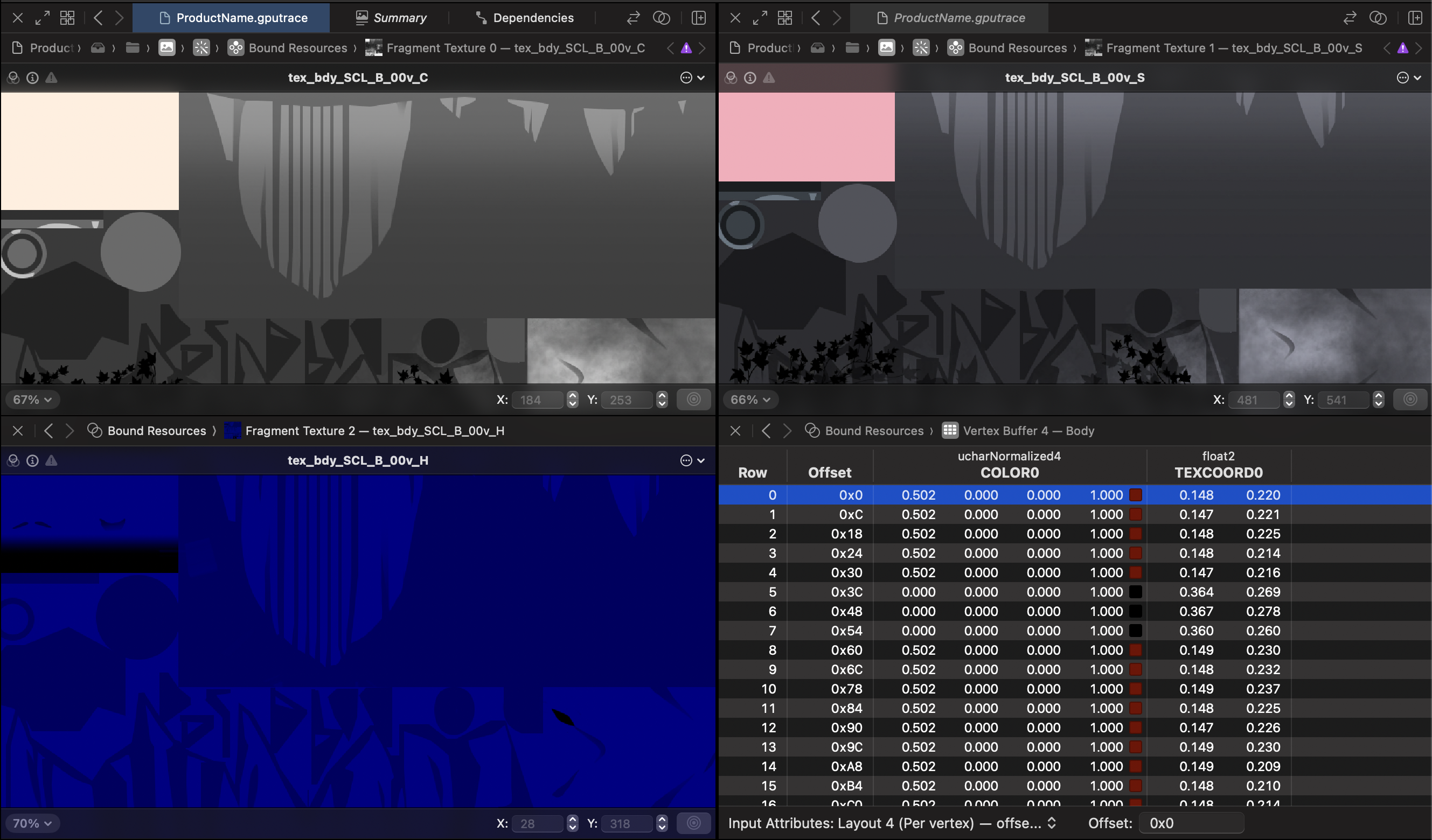
The Vertex Shader section will not be viewed directly; the output TEXCOORD_ section will be explained in the next analysis of the PS
Threshold Shadows
mainTexSmp = _MainTex.sample(sampler_MainTex, input.TEXCOORD1.xy, bias(FGlobals._GlobalMipBias.xyxx.x));
shadowTexSmp.xyz = _ShadowTex.sample(sampler_ShadowTex, input.TEXCOORD1.xy, bias(FGlobals._GlobalMipBias.xyxx.x)).xyz;
valueTexSmp = _ValueTex.sample(sampler_ValueTex, input.TEXCOORD1.xy, bias(FGlobals._GlobalMipBias.xyxx.x));
/* -- lerp shadow / main tex */
shadowValue.xyz = (-float3(mainTexSmp.xyz)) + float3(shadowTexSmp.xyz);
shadowValue.xyz = fma(float3(UnityPerMaterial._ShadowTexWeight), shadowValue.xyz, float3(mainTexSmp.xyz));
// shadowValue: (1-w)*main + w*shadow = lerp(main, shadow, _ShadowTexWeight)
Notice that the real shadows are partially blended by _ShadowTexWeight mixing $T_c, T_s$
/* -- threshold shadow */
charaId = UnityPerMaterial._CharacterId;
charaSpecular.xyz = FGlobals._SekaiCharacterSpecularColorArray[charaId].www * FGlobals._SekaiCharacterSpecularColorArray[charaId].xyz;
lumaOffset = fma(valueTexSmp.z, half(2.0), half(-1.0));
// -1,1
// TEXCOORD3 -> WS normal
lumaValue.x = dot(FGlobals._SekaiDirectionalLight.xyz, input.TEXCOORD3.xyz);
// 0,1
lumaValue.x = fma(lumaValue.x, 0.5, 0.5);
lumaValue.x = float(lumaOffset) + lumaValue.x;
lumaValue.x = clamp(lumaValue.x, 0.0f, 1.0f);
// threshold shadow
// comp luma to threshold
u_xlatb11 = lumaValue.x>=float(FGlobals._SekaiShadowThreshold);
lumaValue.x = (u_xlatb11) ? 0.0 : 1.0;
shadowValue.xyz = fma(shadowValue.xyz, float3(FGlobals._SekaiShadowColor.xyz), (-float3(mainTexSmp.xyz)));
shadowValue.xyz = fma(lumaValue.xxx, shadowValue.xyz, float3(mainTexSmp.xyz));
// shadowValue = lerp(shadowValue * shadowColor, mainTexSmp, lumaValue)
// XXX: this could simply be a conditonal add
Afterwards the selection of shadows/$Tc$ by a single thresholding is completed
Blender implementation
The first thing that can be noted is that - here the point pointing lamp has and only has one
Means one can reuse this one pointing light for lighting throughout the scene with some Trick that will be used later; after all, a pointing/parallel light source is an incident light vector
Threshold Sources
In addition to computing $N \cdot L$ directly, it would be better to use Diffuse BSDF directly.
- Dynamic shadows are available
- Specialized Controls/Gizmo
The Shader is set as follows; Color is pure white, and obviously the resulting brightness is also energy-conserving
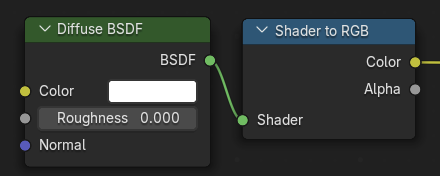
Material Mixing
Temporarily borrow the weights and shadow colors in the pipeline; considering the consistency of these values in the pipeline, it is treated as a Driver to the global object; the operation has been described before

The effect is as follows
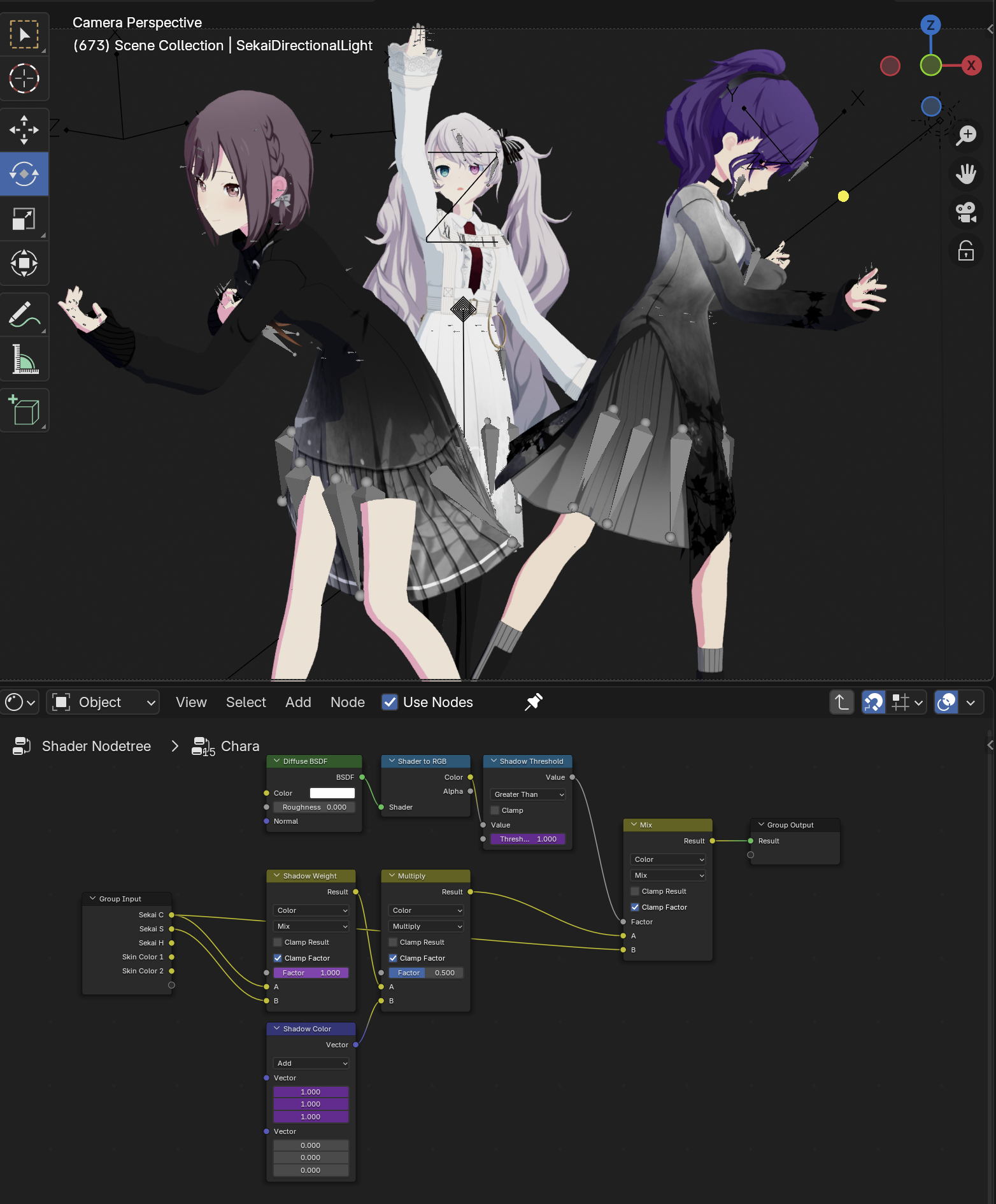
Skin specialization
// -- skin color when shadowed..are they trying to emulate SSS?
u_xlat28 = shadowValue.x * UnityPerMaterial._ShadowTexWeight;
u_xlat28 = fma(lumaValue.x, u_xlat28, float(mainTexSmp.x));
// u_xlat28: main.r + [lit?]luma * (shadowValue.r * _ShadowTexWeight[?])
// shadowed skin color
lumaValue.xyz = float3(FGlobals._SekaiShadowColor.xyz) * UnityPerMaterial._Shadow1SkinColor.xyz;
u_xlat5.xyz = float3(FGlobals._SekaiShadowColor.xyz) * UnityPerMaterial._Shadow2SkinColor.xyz;
lumaOffset = half(u_xlat28 + u_xlat28);
// [0,0.5]->[0,1] clamp upper values?
skinValue.x = half(fma(u_xlat28, 2.0, -1.0));
skinValue.x = clamp(skinValue.x, 0.0h, 1.0h);
skinValue2.xyz = half3(fma((-UnityPerMaterial._Shadow1SkinColor.xyz), float3(FGlobals._SekaiShadowColor.xyz), UnityPerMaterial._DefaultSkinColor.xyz));
skinValue.xyz = half3(fma(float3(skinValue.xxx), float3(skinValue2.xyz), lumaValue.xyz));
// skinValue = lerp([shadowedSkin1]lumaValue, DefaultSkinColor, u_xlat28[0.5,1]->[0,1])
lumaOffset = lumaOffset;
lumaOffset = clamp(lumaOffset, 0.0h, 1.0h); // same as skinValue.x
skinValue.xyz = half3(fma((-UnityPerMaterial._Shadow2SkinColor.xyz), float3(FGlobals._SekaiShadowColor.xyz), float3(skinValue.xyz)));
skinValue.xyz = half3(fma(float3(lumaOffset), float3(skinValue.xyz), u_xlat5.xyz));
// skinValue = lerp([shadowedSkin2]u_xlat5, skinValue, u_xlat28[0,0.5]->[0,1])
// pick between shadowed skin color and plain shadowed color
// XXX: would using condtionals be less expensive? or it's the compiler being silly again
u_xlatb28 = valueTexSmp.x>=half(0.5);
lumaOffset = (u_xlatb28) ? half(1.0) : half(0.0); // value.R over 0.5?
skinValue.xyz = half3((-shadowValue.xyz) + float3(skinValue.xyz));
skinValue.xyz = half3(fma(float3(lumaOffset), float3(skinValue.xyz), shadowValue.xyz));
// skinValue = lerp([shadowed]skinValue, shadowValue, lumaOffset) -> over 0.5: skin region
Blender implementation
$T_h.R$ decides whether to use skin color; borrows some values from the pipeline:

Unfortunately, the $T_h.R$ in the test is all $0$, so there is no effect; the effect of the case where $R$ is all $1$ is as follows:

Rim lights
// -- rim light
shadowValue.xyz = FGlobals._SekaiRimLightColorArray[charaId].www * FGlobals._SekaiRimLightColorArray[charaId].xyz;
// TEXCOORD4 -> normalized view space position -> View Vector -> V
// XXX: since it's interpolated again this needs to be renormalized. apparently they didn't bother...
u_xlat28 = dot(input.NORMAL0.xyz, input.TEXCOORD4.xyz); // NdotV
lumaValue.x = dot(input.TEXCOORD4.xyz, FGlobals._SekaiRimLightArray[charaId].xyz); // VdotL
lumaValue.x = max(lumaValue.x, 0.0);
u_xlat20 = dot(input.NORMAL0.xyz, input.NORMAL0.xyz);
u_xlat20 = rsqrt(u_xlat20);
u_xlat5.xyz = float3(u_xlat20) * input.NORMAL0.xyz; // renormalize normal
u_xlat20 = dot(FGlobals._SekaiRimLightArray[charaId].xyz, FGlobals._SekaiRimLightArray[charaId].xyz);
u_xlat20 = rsqrt(u_xlat20);
u_xlat7.xyz = float3(u_xlat20) * FGlobals._SekaiRimLightArray[charaId].xyz; // normalize L
u_xlat20 = dot(u_xlat5.xyz, u_xlat7.xyz); // NdotL
// -- rim light color
lumaOffset = half(-1.0) + FGlobals._SekaiRimLightShadowSharpnessArray[charaId]; // sharp - 1
charaSpecular3 = half(1.0) + (-FGlobals._SekaiRimLightShadowSharpnessArray[charaId]); // 1 - sharp
rimIntensity = (-float(lumaOffset)) + float(charaSpecular3); // (1 - sharp) - (sharp - 1)
u_xlat4.x = u_xlat20 + (-float(lumaOffset)); // NdotL - (sharp - 1)
rimIntensity = float(1.0) / rimIntensity;
rimIntensity = rimIntensity * u_xlat4.x;
rimIntensity = clamp(rimIntensity, 0.0f, 1.0f);
u_xlat4.x = fma(rimIntensity, -2.0, 3.0);
// https://registry.khronos.org/OpenGL-Refpages/gl4/html/smoothstep.xhtml
rimIntensity = rimIntensity * rimIntensity;
rimIntensity = rimIntensity * u_xlat4.x;
// rimIntensity = smoothstep(sharp - 1, 1 - sharp, NdotL)
u_xlat5.xyz = fma(FGlobals._SekaiShadowRimLightColorArray[charaId].xyz, FGlobals._SekaiShadowRimLightColorArray[charaId].www, (-shadowValue.xyz));
shadowValue.xyz = fma(float3(rimIntensity), u_xlat5.xyz, shadowValue.xyz); // rim light color
// lerp(rim, rimShadow, rimIntensity)
u_xlat28 = max(u_xlat28, 0.0); // NdotV [0,1]
u_xlat28 = (-u_xlat28) + 1.0; // [1,0]
lumaOffset = half(10.0) + (-FGlobals._SekaiRimLightFactor[charaId].x); // 10 - factor.x
u_xlat28 = log2(u_xlat28);
u_xlat28 = u_xlat28 * float(lumaOffset);
u_xlat28 = exp2(u_xlat28);
// (1-NdotV) ^ (10 - factor.x)
lumaValue.x = fma(u_xlat28, lumaValue.x, (-u_xlat28)); // (VdotL - 1) * u_xlat28
u_xlat28 = fma(float(FGlobals._SekaiRimLightFactor[charaId].w), lumaValue.x, u_xlat28);
// += factor_w * (VdotL - 1) * u_xlat28
// u_xlat28 = (1 + factor_w * (VdotL - 1)) * u_xlat28
lumaValue.x = (-u_xlat20) + 0.0500000007;
charaId0 = int((0.0<lumaValue.x) ? 0xFFFFFFFFu : uint(0)); // NdotL < EPS
u_xlati11 = int((lumaValue.x<0.0) ? 0xFFFFFFFFu : uint(0)); // NdotL > EPS
u_xlati11 = (-charaId0) + u_xlati11;// NdotL == 0
lumaValue.x = float(u_xlati11);
lumaValue.x = fma(u_xlat28, lumaValue.x, (-u_xlat28)); // (NdotL - 1) * u_xlat28
u_xlat28 = fma(float(FGlobals._SekaiRimLightFactor[charaId].w), lumaValue.x, u_xlat28);
// u_xlat28 = (1 + factor_w * (NdotL - 1)) * u_xlat28
u_xlat28 = u_xlat28 + (-UnityPerMaterial._RimThreshold);
lumaValue.x = float(1.0) / float(FGlobals._SekaiRimLightFactor[charaId].z);
u_xlat28 = u_xlat28 * lumaValue.x;
u_xlat28 = clamp(u_xlat28, 0.0f, 1.0f);
lumaValue.x = fma(u_xlat28, -2.0, 3.0);
u_xlat28 = u_xlat28 * u_xlat28;
u_xlat28 = u_xlat28 * lumaValue.x;
// smoothstep(0, factor.z, u_xlat28 - RimThreshold)
shadowValue.xyz = shadowValue.xyz * float3(u_xlat28);
lumaValue.xyz = shadowValue.xyz * input.COLOR0.yyy; // Vertex.G: Rim Intensity
skinValue.xyz = half3(fma(shadowValue.xyz, input.COLOR0.yyy, float3(skinValue.xyz)));
The amount of code is a bit much… But it’s clear when it’s written as an equation. $$ a = smoothstep(sharpness - 1, 1 - sharpness, \hat{\mathbf{N}} \cdot \hat{\mathbf{L}}) \newline b = (1 - \hat{\mathbf{N}} \cdot \hat{\mathbf{V}})^{10 - factor_x} \newline c = (1 + factor_w * (\hat{\mathbf{V}} \cdot \hat{\mathbf{L}})) * b \newline d = c * (\hat{\mathbf{N}} \cdot \hat{\mathbf{L}} > 0)\newline e = smoothstep(0, factor_z, d - threshold) \newline I_{rim} = e * Color_0.y $$
$a$ is used to calculate the light color $$ C = lerp(C_{rim},C_{rimShadow},a) $$
$b$ is the estimated form of the Fresnel term $$ R(\theta) = R_0 + (1 - R_0)(1 - \cos \theta)^5 $$ Consider $R_0$ close to $0$ omitted; the output effect alone is as follows

Continue with perspective-related contributions in $c$.
The $d$ clips the backlighting.
Finally do the addition directly to the previous calculation $$ C_{frag} += I_{rim} * C $$
Blender implementation
Highlighting light source?
The first thing worth noting is that this light source is one per character and, at the same time, still comes in the form of parallel lighting
Maintaining a light source is sufficient; however, it is clear that since the light formula is very non-PBR it is not possible to directly use the Specular BSDF == here the alternative is to
Use an Empty object to take the pointing vector $-E$ as our $L$; from the above equation, we know that we don’t need to consider attenuation, etc., so it’s enough.
The notation incident $L$ is recorded here as the coloring point to the light source pointing; therefore, $-E$ rather than $E$ is required.
Shaders can be implemented like this
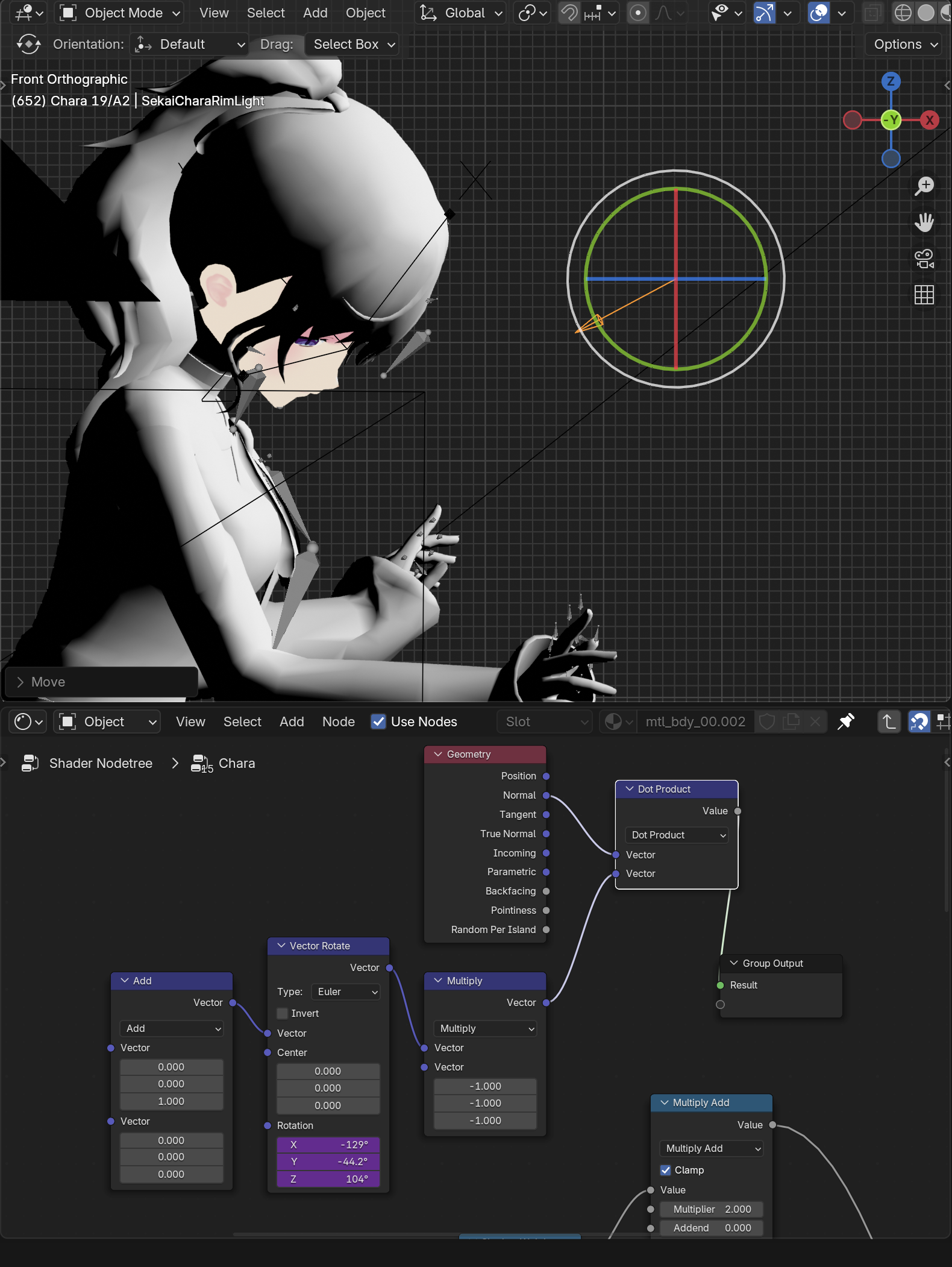
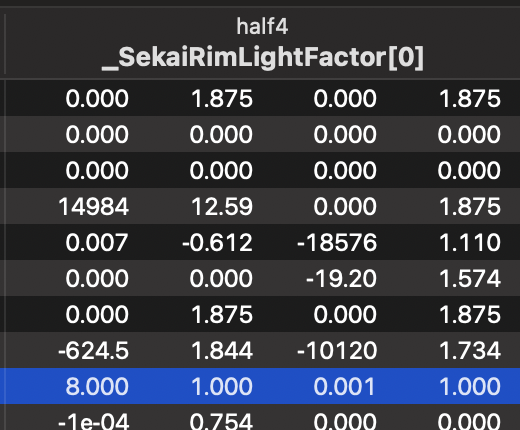
After the implementation of the effect as shown in the figure
catching

persist (in memory)

Mixed as shown
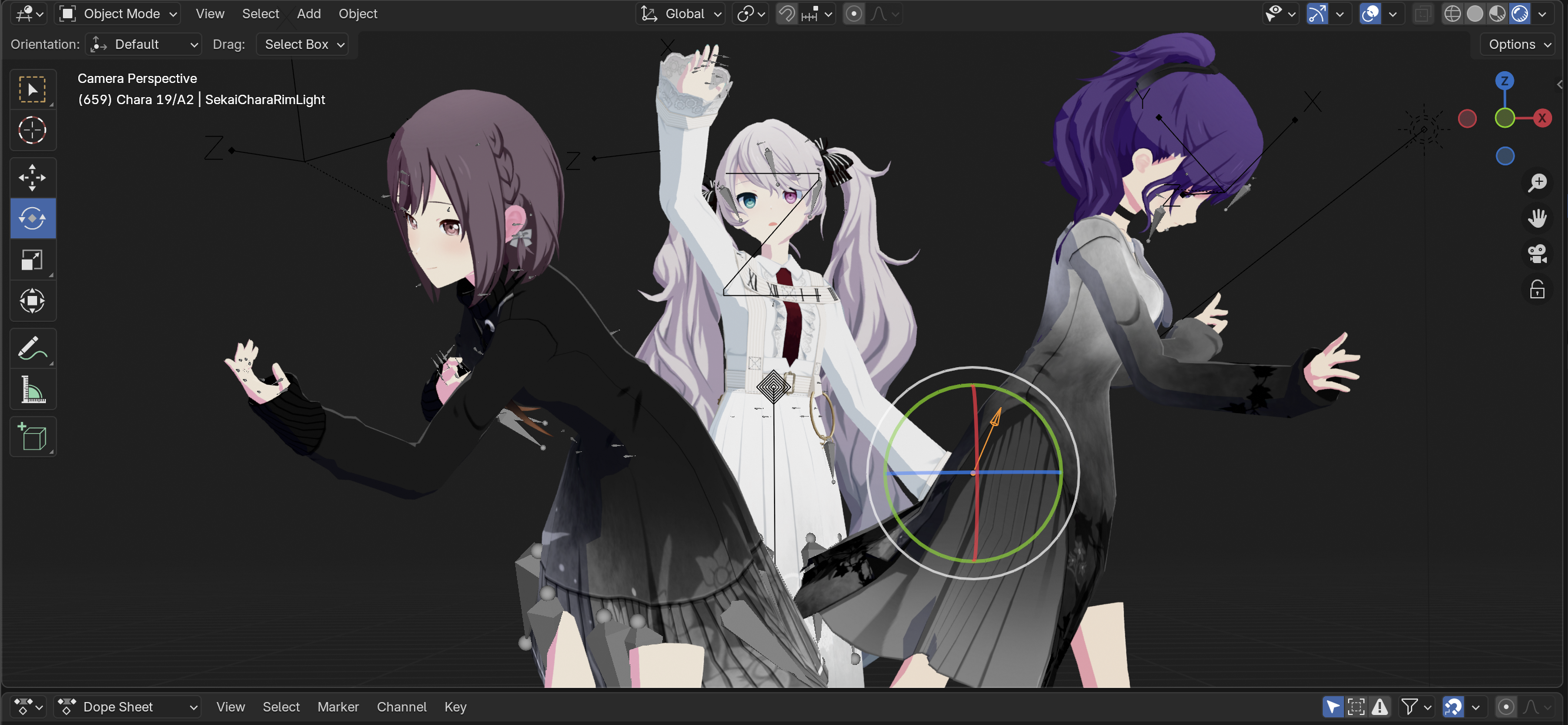
Overall highlights
// charaSpecular.xyz = FGlobals._SekaiCharacterSpecularColorArray[charaId].www * FGlobals._SekaiCharacterSpecularColorArray[charaId].xyz;
// -- directional light specular
shadowValue.xyz = input.TEXCOORD4.xyz + FGlobals._SekaiDirectionalLight.xyz; // V + L
u_xlat28 = dot(shadowValue.xyz, shadowValue.xyz);
u_xlat28 = rsqrt(u_xlat28);
shadowValue.xyz = float3(u_xlat28) * shadowValue.xyz; // normalize V + L
shadowValue.x = dot(shadowValue.xyz, input.NORMAL0.xyz);
shadowValue.x = max(shadowValue.x, 0.0);
shadowValue0.x = 10.0 / UnityPerMaterial._SpecularPower;
shadowValue.x = log2(shadowValue.x);
shadowValue.x = shadowValue.x * shadowValue0.x;
shadowValue.x = exp2(shadowValue.x);
// ((V+L)*N) ^ (10/SpecularPower)
shadowValue.xyz = float3(charaSpecular.xyz) * shadowValue.xxx; // specular color
shadowValue.xyz = fma(shadowValue.xyz, float3(valueTexSmp.www), float3(skinValue.xyz)); // value.a: specular intensity
Here it looks like the classic [Blinn-Phong model](https://en.wikipedia.org/wiki/Blinn%E2%80%93Phong_reflection_model#High-Level_Shading_Language_code_ sample)
To save time… The implementation uses Specular BSDF instead.
Note the selectivity of $T_a$ for highlights
Blender implementation
Effective on some ‘metal’ objects, such as the image below.
opens

cloture
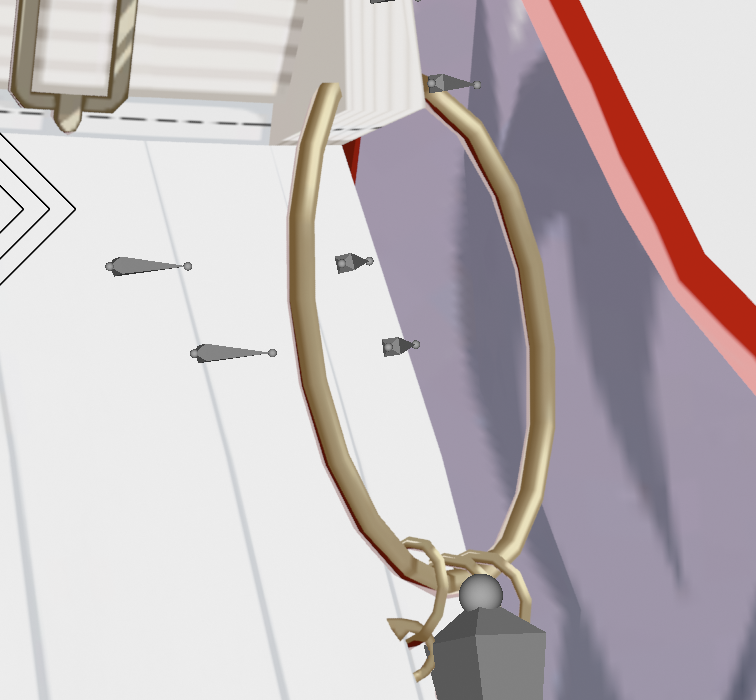
Ambient Lighting
// -- ambient lights
u_xlatb4.xzw = (shadowValue.xyz>=float3(0.5, 0.5, 0.5));
charaSpecular.x = (u_xlatb4.x) ? half(1.0) : half(0.0);
charaSpecular.y = (u_xlatb4.z) ? half(1.0) : half(0.0);
charaSpecular.z = (u_xlatb4.w) ? half(1.0) : half(0.0);
skinValue.xyz = half3(shadowValue.xyz + shadowValue.xyz);
u_xlat4.xzw = float3(skinValue.xyz) * FGlobals._SekaiCharacterAmbientLightColorArray[charaId].xyz;
shadowValue6_8.xyz = half3((-shadowValue.xyz) + float3(1.0, 1.0, 1.0));
shadowValue6_8.xyz = shadowValue6_8.xyz + shadowValue6_8.xyz;
shadowValue.xyz = float3(1.0, 1.0, 1.0) + (-FGlobals._SekaiCharacterAmbientLightColorArray[charaId].xyz);
shadowValue.xyz = fma((-float3(shadowValue6_8.xyz)), shadowValue.xyz, float3(1.0, 1.0, 1.0));
skinValue.xyz = half3(fma((-float3(skinValue.xyz)), FGlobals._SekaiCharacterAmbientLightColorArray[charaId].xyz, shadowValue.xyz));
charaSpecular.xyz = half3(fma(float3(charaSpecular.xyz), float3(skinValue.xyz), u_xlat4.xzw));
shadowValue.xyz = float3(charaSpecular.xyz) * float3(FGlobals._SekaiCharacterAmbientLightIntensityArray[charaId]);
u_xlat4.xzw = shadowValue.xyz * float3(FGlobals._SekaiAllLightIntensity);
charaSpecular.xyz = half3(fma((-shadowValue.xyz), float3(FGlobals._SekaiAllLightIntensity), float3(1.0, 1.0, 1.0)));
charaSpecular.xyz = charaSpecular.xyz + charaSpecular.xyz;
skinValue.xyz = (-UnityPerMaterial._PartsAmbientColor.xyz) + half3(1.0, 1.0, 1.0);
charaSpecular.xyz = fma((-charaSpecular.xyz), skinValue.xyz, half3(1.0, 1.0, 1.0));
skinValue.xyz = half3(fma(u_xlat4.xzw, float3(UnityPerMaterial._PartsAmbientColor.xyz), (-float3(charaSpecular.xyz))));
charaSpecular.xyz = fma(UnityPerMaterial._PartsAmbientColor.www, skinValue.xyz, charaSpecular.xyz);
Blender implementation
Mixed mode is direct multiplication, details omitted for now
The effect is as shown in the picture.
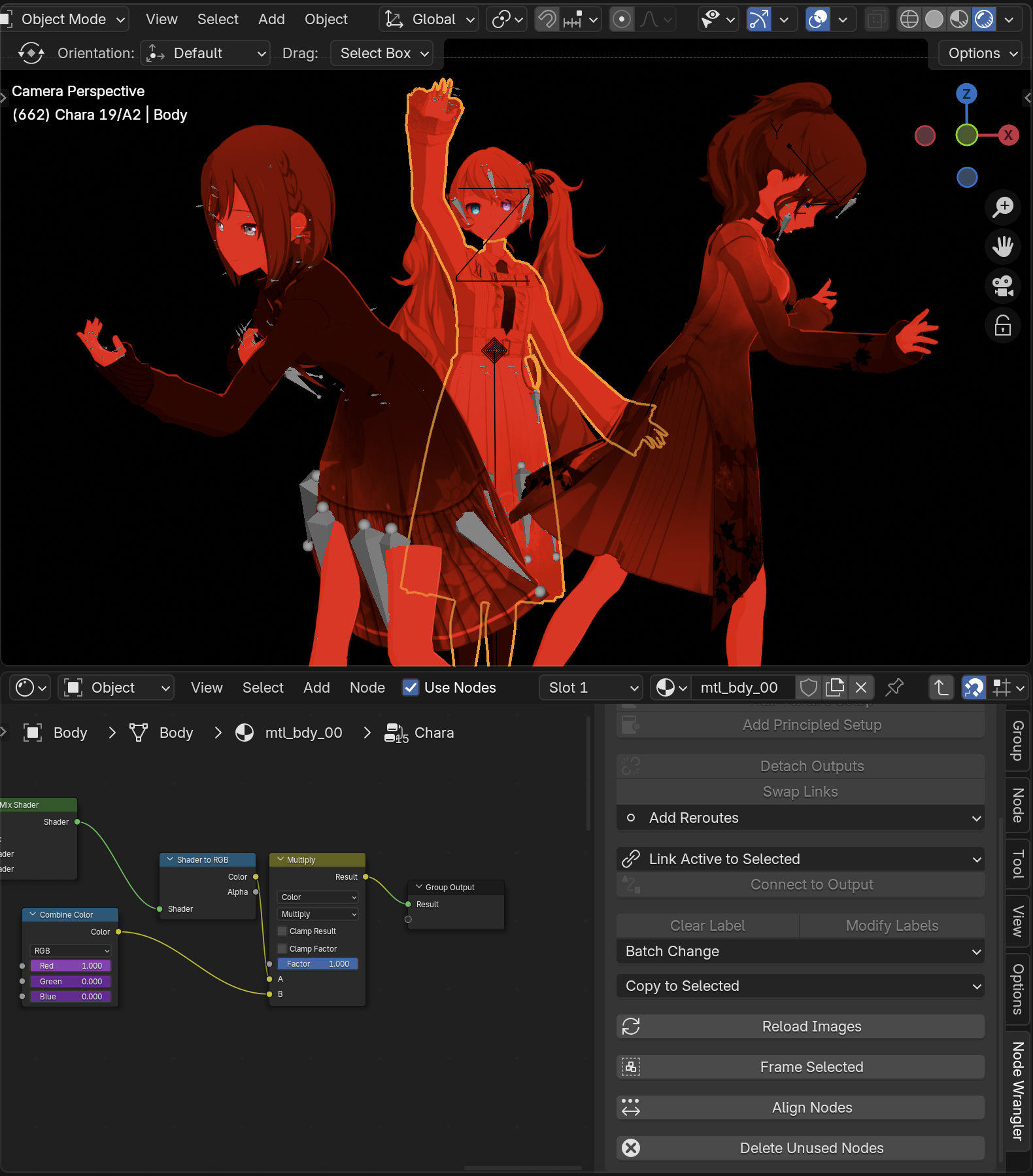
Point light support
// -- add spot attenuation
u_xlatb1 = 0x0<FGlobals._SekaiGlobalSpotLightEnabled;
if(u_xlatb1){
shadowValue.xyz = (-input.TEXCOORD5.xyz) + FGlobals._SekaiGlobalSpotLightPos.xyzx.xyz;
shadowValue.xy = shadowValue.xy * shadowValue.xy;
shadowValue.x = shadowValue.y + shadowValue.x;
shadowValue.x = fma(shadowValue.z, shadowValue.z, shadowValue.x);
shadowValue0.x = (-FGlobals._SekaiGlobalSpotLightRadiusNear) + FGlobals._SekaiGlobalSpotLightRadiusFar;
shadowValue.x = shadowValue.x + (-FGlobals._SekaiGlobalSpotLightRadiusNear);
shadowValue0.x = float(1.0) / shadowValue0.x;
shadowValue.x = shadowValue0.x * shadowValue.x;
shadowValue.x = clamp(shadowValue.x, 0.0f, 1.0f);
shadowValue0.x = fma(shadowValue.x, -2.0, 3.0);
shadowValue.x = shadowValue.x * shadowValue.x;
shadowValue9 = shadowValue.x * shadowValue0.x;
shadowValue.x = fma((-shadowValue0.x), shadowValue.x, 1.0);
shadowValue0.xyz = float3(charaSpecular.xyz) * float3(shadowValue9);
shadowValue0.xyz = shadowValue0.xyz * FGlobals._SekaiGlobalSpotLightColor.xyz;
shadowValue.xyz = fma(shadowValue.xxx, float3(charaSpecular.xyz), shadowValue0.xyz);
} else {
shadowValue.xyz = float3(charaSpecular.xyz);
}
incorporation
u_xlat2.xyz = lumaValue.xyz * float3(FGlobals._SekaiRimLightFactor[charaId].yyy);
u_xlat2.xyz = fma(shadowValue.xyz, float3(valueTexSmp.yyy), u_xlat2.xyz);
charaSpecular.x = (-input.TEXCOORD6) + half(1.0);
u_xlat28 = float(charaSpecular.x) * FGlobals._SekaiFogColor.w;
u_xlat4.xyz = (-shadowValue.xyz) + FGlobals._SekaiFogColor.xyz;
mainTexSmp.xyz = half3(fma(float3(u_xlat28), u_xlat4.xyz, shadowValue.xyz));
shadowValue.x = input.TEXCOORD7 / input.TEXCOORD0.w;
shadowValue.x = fma(FGlobals._ZBufferParams.z, shadowValue.x, FGlobals._ZBufferParams.w);
shadowValue.x = fma((-FGlobals._CoCParams.x), shadowValue.x, 1.0);
shadowValue.x = shadowValue.x * FGlobals._CoCParams.y;
shadowValue0.x = shadowValue.x;
shadowValue0.x = clamp(shadowValue0.x, 0.0f, 1.0f);
shadowValue.x = max(shadowValue.x, -1.0);
shadowValue.x = min(shadowValue.x, 0.0);
shadowValue.x = shadowValue.x + shadowValue0.x;
shadowValue.x = shadowValue.x + 1.0;
shadowValue.x = shadowValue.x * 0.5;
output.SV_Target0 = mainTexSmp;
output.SV_Target1.x = half(shadowValue.x);
output.SV_Target1.yzw = half3(0.0, 0.0, 1.0);
output.SV_Target2.xyz = half3(u_xlat2.xyz);
output.SV_Target2.w = half(1.0);
return output;
}
final result
(Waiting for a picture)
3. Stage/LightMap
This part is fairly simple - mix the baked LightMap, ambient light and Diffuse and you’re done!
Note that the use of the Vertex Color section also has an effect
...
u_xlat16_0 = _MainTex.sample(sampler_MainTex, input.TEXCOORD1.xy);
u_xlat16_1 = _LightMapTex.sample(sampler_LightMapTex, input.TEXCOORD2.xy);
u_xlat0 = float4(u_xlat16_0) * input.COLOR0;
u_xlat0 = u_xlat0 * float4(u_xlat16_1);
u_xlat19 = u_xlat0.w + u_xlat0.w;
u_xlatb2.xyz = (u_xlat0.xyz>=float3(0.25, 0.25, 0.25));
u_xlat16_3.x = (u_xlatb2.x) ? half(1.0) : half(0.0);
u_xlat16_3.y = (u_xlatb2.y) ? half(1.0) : half(0.0);
u_xlat16_3.z = (u_xlatb2.z) ? half(1.0) : half(0.0);
u_xlat16_4.xyz = half3(u_xlat0.xyz * float3(4.0, 4.0, 4.0));
u_xlat2.xyz = float3(u_xlat16_4.xyz) * FGlobals._SekaiAmbientLightColor.xyz;
u_xlat16_5.xyz = half3(fma((-u_xlat0.xyz), float3(2.0, 2.0, 2.0), float3(1.0, 1.0, 1.0)));
u_xlat16_5.xyz = u_xlat16_5.xyz + u_xlat16_5.xyz;
u_xlat0.xyz = (-FGlobals._SekaiAmbientLightColor.xyz) + float3(1.0, 1.0, 1.0);
u_xlat0.xyz = fma((-float3(u_xlat16_5.xyz)), u_xlat0.xyz, float3(1.0, 1.0, 1.0));
u_xlat16_4.xyz = half3(fma((-float3(u_xlat16_4.xyz)), FGlobals._SekaiAmbientLightColor.xyz, u_xlat0.xyz));
u_xlat16_3.xyz = half3(fma(float3(u_xlat16_3.xyz), float3(u_xlat16_4.xyz), u_xlat2.xyz));
u_xlat0.xyz = float3(u_xlat16_3.xyz) * float3(FGlobals._SekaiLightIntensity);
u_xlat0.xyz = u_xlat0.xyz * float3(FGlobals._SekaiAllLightIntensity);
u_xlatb18 = 0x0<FGlobals._SekaiGlobalSpotLightEnabled;
...
final result
(Waiting for a picture)
4. Toon (stroke)
Note: Reading 5 ways to draw an outline is highly recommended as prior knowledge!
Straight away, the Vertex Shader is labeled as follows
Mtl_VertexOut output;
float4 position;
float4 position2;
float3 u_xlat2;
position.xyz = input.POSITION0.yyy * UnityPerDraw.hlslcc_mtx4x4unity_ObjectToWorld[1].xyz;
position.xyz = fma(UnityPerDraw.hlslcc_mtx4x4unity_ObjectToWorld[0].xyz, input.POSITION0.xxx, position.xyz);
position.xyz = fma(UnityPerDraw.hlslcc_mtx4x4unity_ObjectToWorld[2].xyz, input.POSITION0.zzz, position.xyz);
position2.xyz = position.xyz + UnityPerDraw.hlslcc_mtx4x4unity_ObjectToWorld[3].xyz;
// World Space
output.TEXCOORD2.xyz = fma(UnityPerDraw.hlslcc_mtx4x4unity_ObjectToWorld[3].xyz, input.POSITION0.www, position.xyz);
position.xyz = position2.xyz + (-VGlobals._WorldSpaceCameraPos.xyzx.xyz);
// View space
position.x = dot(position.xyz, position.xyz);
position.x = sqrt(position.x); // View Distance
position.x = position.x + (-VGlobals._SekaiOutlineFactor.x);
position.x = position.x * VGlobals._SekaiOutlineFactor.y;
position.x = clamp(position.x, 0.0f, 1.0f);
position.x = position.x * VGlobals._SekaiOutlineFactor.z;
position.x = min(position.x, 1.0); // [0,1]
u_xlat2.x = (-VGlobals._SekaiOutlineWidth.x) + VGlobals._SekaiOutlineWidth.y;
position.x = fma(position.x, u_xlat2.x, VGlobals._SekaiOutlineWidth.x);
// px = lerp(OutlineWidth.x, OutlineWidth.y, clamp((length(View) - Factor.x) * Factor.y,0,1) * Factor.z)
u_xlat2.x = dot(input.NORMAL0.xyz, input.NORMAL0.xyz);
u_xlat2.x = rsqrt(u_xlat2.x);
u_xlat2.xyz = u_xlat2.xxx * input.NORMAL0.xyz;
// N = normalize(N)
position.xyz = position.xxx * u_xlat2.xyz;
// Extrude by normal
position.xyz = fma(position.xyz, input.COLOR0.xxx, input.POSITION0.xyz);
// Done!
position2.xyz = position.yyy * UnityPerDraw.hlslcc_mtx4x4unity_ObjectToWorld[1].xyz;
position.xyw = fma(UnityPerDraw.hlslcc_mtx4x4unity_ObjectToWorld[0].xyz, position.xxx, position2.xyz);
position.xyz = fma(UnityPerDraw.hlslcc_mtx4x4unity_ObjectToWorld[2].xyz, position.zzz, position.xyw);
position.xyz = position.xyz + UnityPerDraw.hlslcc_mtx4x4unity_ObjectToWorld[3].xyz;
position2 = position.yyyy * VGlobals.hlslcc_mtx4x4unity_MatrixVP[1];
position2 = fma(VGlobals.hlslcc_mtx4x4unity_MatrixVP[0], position.xxxx, position2);
position = fma(VGlobals.hlslcc_mtx4x4unity_MatrixVP[2], position.zzzz, position2);
position = position + VGlobals.hlslcc_mtx4x4unity_MatrixVP[3];
// Screen Space Position
output.mtl_Position = position;
// Screen Space Position
output.TEXCOORD0 = position;
output.COLOR0 = input.COLOR0;
// Z depth (NDC)
output.TEXCOORD4 = position.z;
position.x = position.z / VGlobals._ProjectionParams.y;
position.x = (-position.x) + 1.0;
position.x = position.x * VGlobals._ProjectionParams.z;
position.x = max(position.x, 0.0);
position.x = fma((-VGlobals._SekaiFogFactor.xyxx.y), position.x, VGlobals._SekaiFogFactor.xyxx.x);
position.x = clamp(position.x, 0.0f, 1.0f);
output.TEXCOORD3 = half(position.x);
output.TEXCOORD1.xy = fma(input.TEXCOORD0.xy, UnityPerMaterial._MainTex_ST.xy, UnityPerMaterial._MainTex_ST.zw);
return output;
Pipeline FrontFacingWinding to CounterClockwise, i.e., flip the Vertex order, and just Cull off the original front-facing portion of the geometry.
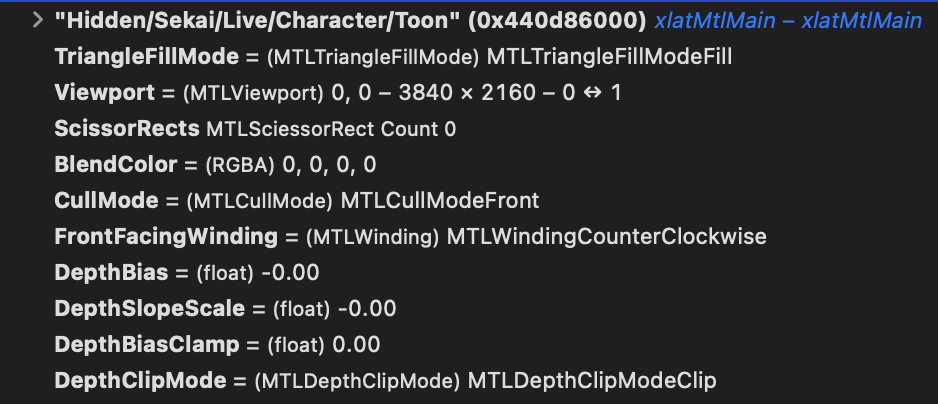
Implementation details, i.e., one sentence, in the World Space direct practice line extension, more classic $$ P_{shell} = P + N * VertexColor_x * lerp(OutlineWidth_x, OutlineWidth_y, clamp((length(View) - Factor_x) * Factor_y,0,1) * Factor_z) $$
There’s also a Color layer for fine-tuning the intensity of the stroke for the art, which is an industry norm.
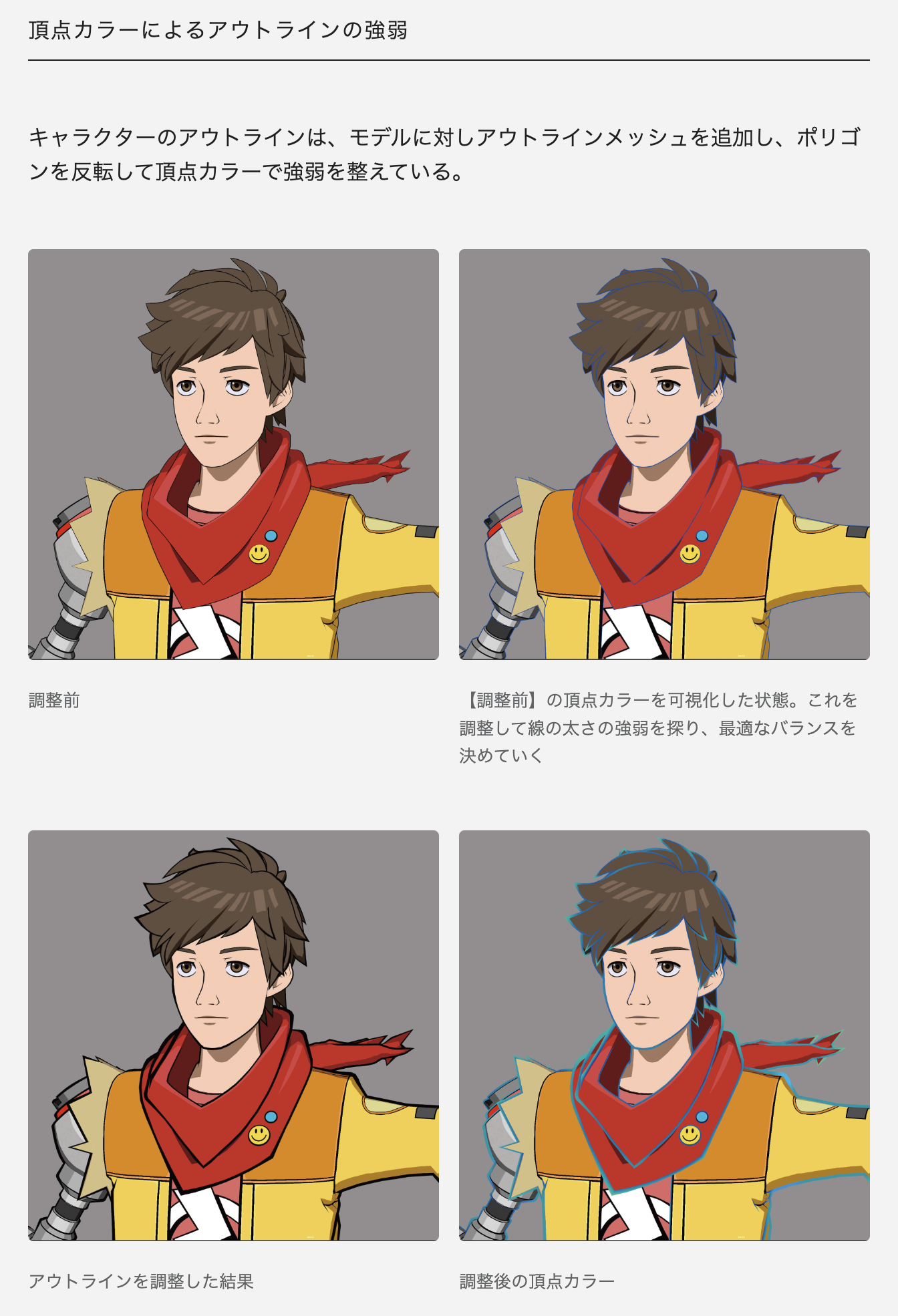
(Source: https://cgworld.jp/article/202306-hifirush01.html)
final result
(Waiting for a picture)